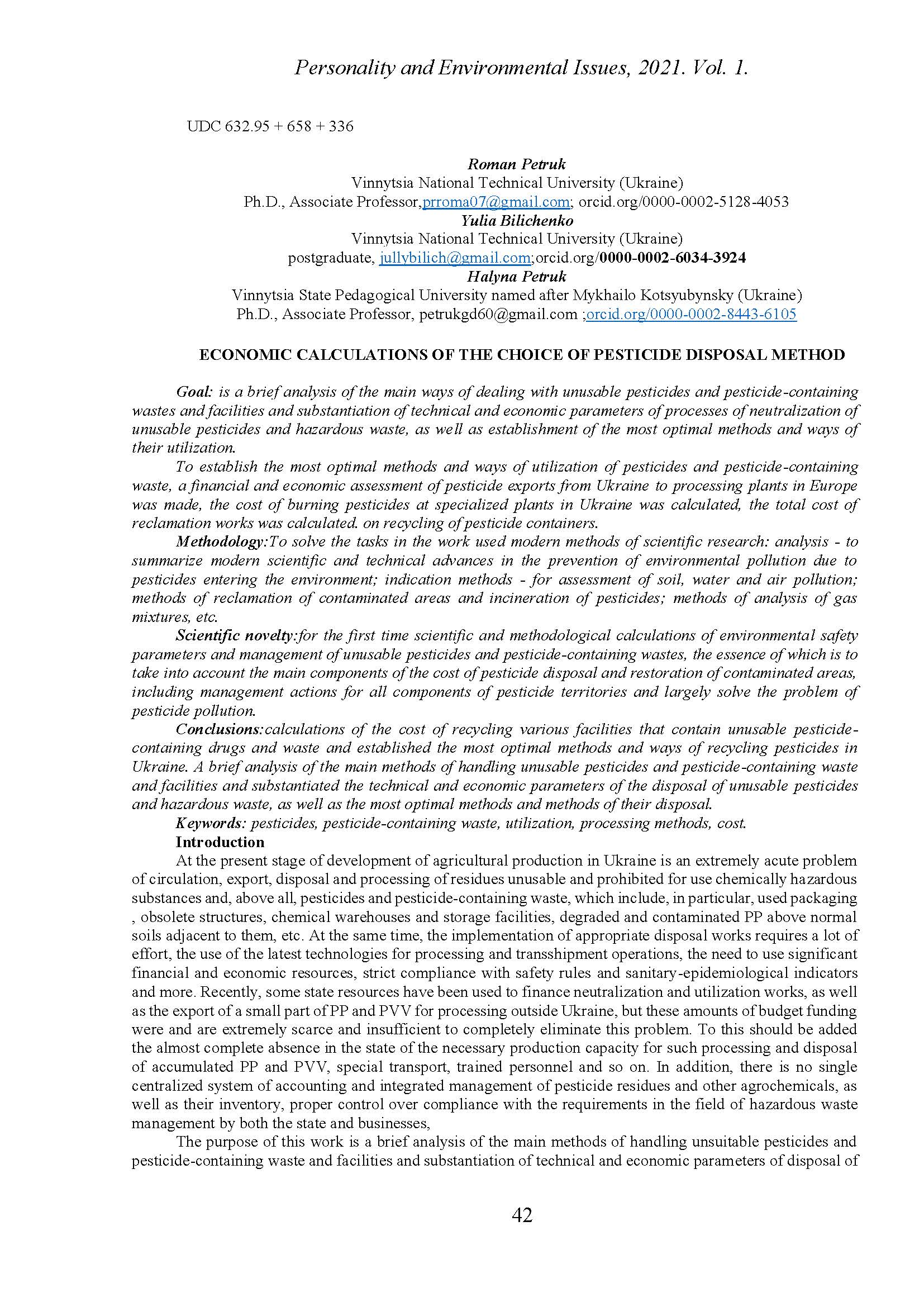Abstract
Goal: is a brief analysis of the main ways of dealing with unusable pesticides and pesticide-containing wastes and facilities and substantiation of technical and economic parameters of processes of neutralization of unusable pesticides and hazardous waste, as well as establishment of the most optimal methods and ways of their utilization. To establish the most optimal methods and ways of utilization of pesticides and pesticide-containing waste, a financial and economic assessment of pesticide exports from Ukraine to processing plants in Europe was made, the cost of burning pesticides at specialized plants in Ukraine was calculated, the total cost of reclamation works was calculated. on recycling of pesticide containers. Methodology: To solve the tasks in the work used modern methods of scientific research: analysis - to summarize modern scientific and technical advances in the prevention of environmental pollution due to pesticides entering the environment; indication methods - for assessment of soil, water and air pollution; methods of reclamation of contaminated areas and incineration of pesticides; methods of analysis of gas mixtures, etc. Scientific novelty: for the first time scientific and methodological calculations of environmental safety parameters and management of unusable pesticides and pesticide-containing wastes, the essence of which is to take into account the main components of the cost of pesticide disposal and restoration of contaminated areas, including management actions for all components of pesticide territories and largely solve the problem of pesticide pollution. Conclusions: calculations of the cost of recycling various facilities that contain unusable pesticide-containing drugs and waste and established the most optimal methods and ways of recycling pesticides in Ukraine. A brief analysis of the main methods of handling unusable pesticides and pesticide-containing waste and facilities and substantiated the technical and economic parameters of the disposal of unusable pesticides and hazardous waste, as well as the most optimal methods and methods of their disposal.
References
Transportuvannya, zberihannya ta zastosuvannya pestytsydiv u narodnomu hospodarstvi. State sanitary rules. Наказ МОЗУ №1 03.08.1998 р.
About zatverdzhennya rules dorozhnyoho perevezennya nebezpechnykh vantazhiv. Order of the Ministry of Internal Affairs of Ukraine 26.07.2004 р. №822
Law of Ukraine "On pesticides and achrochemicals", (86/95 VR). Closed postanovoyu Verkhovnoyi Rady Ukrayiny vid 02.03.95
Petruk RV Naukove obgruntuvannya optymalnykh form intehrovanoho upravlinnya ekolohichnoyu bezpekoyu neprydatnykh pestytsydiv ta pestytsydvmisnykh vidkhodiv: dys… doktora tekhn. Science: 21.06.01 / Petruk Roman Vasilyovych. - K., 2020. –345 p.
Arzu Özkara. Pesticides, Environmental Pollution, and Health / Arzu Özkara, Dilek Akyıl and Muhsin Konuk / Environmental Health Risk - Hazardous Factors to Living Species - 2016 [DOI: 10.5772 / 63094]
World Bank / WHO / UNEP. 1989. The safe disposal of hazardous wastes: the special needs and problems of developing countries, Vols. I - III. World Bank Technical Paper No. 93. R. Batstone, JE Smith Jr. and D. Wilson. Washington, DC.
Mosse AL, Savchenko GE, Savchin VV, Levashov AV Mobile Plasma Systems. Variants of Design, Application and Comparative Analysis. - Journal “Energy technologies and resource saving”, Moscov.– 2012. - “4. - p 8-15.
US-EPA. 1994a. Innovative site remediation technology; thermal destruction; Volume 7 Pub. No. EPA 542-B-94-003. Washington, DC.
M. Gordon, N. Choe, J. Duffy, G. Ekuan, P. Heilman, I. Muiznieks, M. Ruszaj, BB Shurtleff, S. Strand, J. Wilmoth and LA Newman, “Phytoremediaiton of Trichloroethylene with Hybrid Poplars, ”Environmental Health Perspectives Supplements, Vol. 106, no. 4, 1998, pp. 1001- 1004. doi: 10.1289 / ehp.98106s41001
Mariam T. Al Khattab, Abdel E. Ghaly. Disposal and Treatment Methods for Pesticide Containing Wastewaters: Critical Review and Comparative Analysis / Mariam T. Al Hattab, Abdel E. Ghaly / Journal of Environmental ProtectionVol. 3 No. 5 (2012), Article ID: 19535, 23 pages DOI: 10.4236 / jep.2012.35054

This work is licensed under a Creative Commons Attribution 4.0 International License.
Copyright (c) 2022 Personality and Environmental Issues




